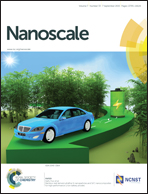Electrical-field-driven metal–insulator transition tuned with self-aligned atomic defects†
Abstract
Recently, significant attention has been paid to the resistance switching (RS) behaviour in Fe3O4 and it was explained through the analogy of the electrically driven metal–insulator transition based on the quantum tunneling theory. Here, we propose a method to experimentally support this explanation and provide a way to tune the critical switching parameter by introducing self-aligned localized impurities through the growth of Fe3O4 thin films on stepped SrTiO3 substrates. Anisotropic behavior in the RS was observed, where a lower switching voltage in the range of 104 V cm−1 is required to switch Fe3O4 from a high conducting state to a low conducting state when the electrical field is applied along the steps. The anisotropic RS behavior is attributed to a high density array of anti-phase boundaries (APBs) formed at the step edges and thus are aligned along the same direction in the film which act as a train of hotspot forming conduits for resonant tunneling. Our experimental studies open an interesting window to tune the electrical-field-driven metal–insulator transition in strongly correlated systems.


 Please wait while we load your content...
Please wait while we load your content...